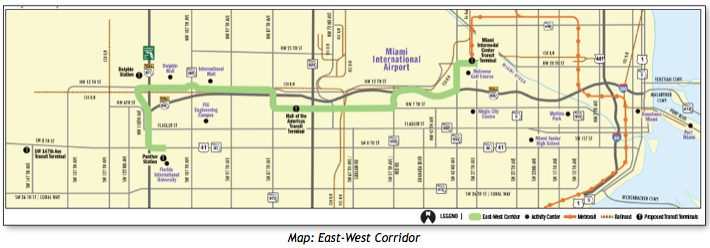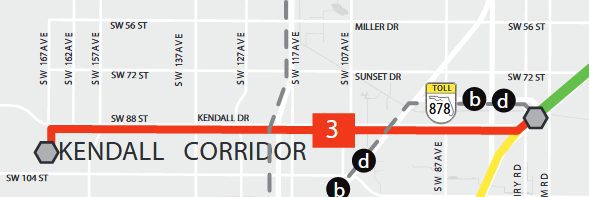
When talking about the SMART plan, the first thing you need to realize is that, beyond being ambitious, it is also multi-dimensional. By that I mean that each component must be viewed in light of specific conditions within the region in question.
Before we tackle the individual components, let’s do a quick overview: The SMART plan is composed of six corridors and roughly sixty miles of new mass transit connectors. The total current estimate of the capital costs is $3.6 billion, which means we are working with an average of $60 million per mile.
Funding has so far been provided for the North and South components, which Chairman Esteban Bovo refers to as the spinal column of the system. Because the Metrorail will connect Florida City at the southernmost border of the county, one could travel along the South Dade Transitway all the way up Northwest 27th Avenue to the northern edge of the county, where the Hard Rock Stadium is located.

As to the other four components, the funding is as follows:
1) East-West connector: This should be funded by a combination of MDX excess revenues and the new tax-increment initiative. Although the latter does not kick in until 2023, it will hopefully provide substantial funds along this particular corridor.

2) Baylink: This line, connecting Downtown to South Beach, is proposed to be funded by a special taxing district similar to what was used for the Metromover extensions. At a recent Sunshine Meeting on Baylink, Mayor Gimenez clarified that the prior use of special taxing districts for the Metromover extensions were used to cover 15% of the 25% local share. A similar special taxing district could be used to fund all or a significant portion of the local share required to obtain state matching funds.
Steve Hamilton of CityTram, proposed this innovative transit solution during our sunshine meeting on trolleys and has been actively engaged in our ongoing discussions with the County.

3) The Northeast (FEC) corridor: This is actually a railroad track at grade already being built (and close to completion which should be in April) by the Florida East Coast Railway (FEC) for use in its four-city service. That four-city service is called “All Aboard.” By purchasing the right to use the track that extends from Downtown Miami to Aventura, during the time that All Aboard is not using it, we can provide commuter train service almost immediately.
At a recent Transportation Planning Organization (TPO) meeting, Commissioner Sally Heyman expressed her concern that there seemed to be a delay in negotiating what is called a “track access fee,” meaning the rent payments that would cover the use of the track for the commuter trains.
She’s right to stress the importance of that. The cost for this corridor is minimal, both because FEC is doing the bulk of the construction on its dime and on its right-of-way, and because the cities and property owners along the track are quite willing to build their own transit stops. Moreover, it appears that a couple of Tri-Rail trains are available, to put on this track. Therefore, the initial capital cost is negligible.
4) Kendall corridor: This can be done radially (connecting Dadeland to 137th Avenue) or by purchasing the right-of-way from CSX on its existing freight line, which runs parallel at approximately SW 144th St). Given that there is no present funding for that, I have advanced the idea of using trolley service – which can also be mini buses dressed to look like trolleys – to begin at least minimal service on the approximately 10 miles connecting Dadeland to 137th Avenue along SW 88th Street.

Interim Solution: Trolleys and Circulators:
The advantage of trolleys on wheels, also referred to as “rubberized mass transit,” is that there are no substantial infrastructure costs. The other advantage, of course, is that people throughout the county are enthusiastically embracing this form of mass transit.
The reasons why many riders love trolleys are many, but the primary reason is that they are fare free. By way of example, the City of Miami Trolley ridership numbers for November 2017 are as follows: Little Havana- 80,645, Coral Way – 79,987, Biscayne – 67,718, Allapattah – 66,082. Their operations and capital costs must be subsidized by a funding source, which in this case is rightly the existing one, the “half penny” surtax. In this connection, it should be mentioned that many municipalities have used their 20% share of the half cent (adding up to about $50 million) to fund trolley service, including Coral Gables, Miami, Miami Beach, and Doral.
Issues Pending on the East-West Connector:
And that brings me back to the East-West connector, which is at this point missing both an alignment and a funding source (UMSA is not eligible to receive the 20% of the half penny that is allocated to cities, leaving the East-West connector without the option to utilize a share of the half cent). To address this funding gap, I have proposed a resolution directing the Administration to develop a funding plan that would allow for free-fare service for neighborhood circulators in UMSA.
At a Sunshine Meeting with County Commissioner Rebeca Sosa and Miami City Commissioner Manolo Reyes (I will be following that up with a Sunshine meeting with Commissioner Javier Souto and Commissioner Joe Martinez), I proposed that we dovetail with the city’s intended extension of their Flagler service – currently projected to reach the city limits at SW 72nd Avenue – and continue all the way to 107th Avenue (FIU). If we do this along Flagler, we will have begun the effort of getting people out of their cars and into mass transit in one fell swoop along this important corridor. Imagine being able to travel for free from FIU to Downtown Miami, and vice versa, in vehicles that provide free Wi-Fi and are handicap-accessible.
Rail vs. Bus Dilemma:
Note that I have avoided the battle between those who propose serving some of the corridors with buses and those who want rail. The reason is because that battle is only currently a factor as to the East-West connector. In the case of Baylink, it is particularly unnecessary to argue about technology because Baylink, of necessity, is an elevated guideway of some sort. More importantly, those {3.2} miles can be served by very light rail, commonly referred to as Personal Rapid Transit (PRT). In a recent Sunshine Meeting, that concept was embraced by the mayors of the City of Miami and Miami-Dade County for reasons that become clear when you consider that its cost is approximately 10% of what the Metromover extensions cost and 4% of what Metrorail costs. In the case of the Northeast/FEC corridor, the rail is at grade, and it would be senseless to invent a new system or technology or right-of-way when that one is already there for the taking (or rather the “renting”). Last but not least, with the North and South corridors, according to the public officials that represent those areas both in the legislature and the county commission as well as municipalities, there is consensus for light rail at-grade. So are we on the verge of a transcendent, innovative culmination to our many years of study and polemics? I think so and the facts support it.

Miami-Dade County Commissioner Xavier L. Suarez can be reached at 305-669-4003 or via email at district7@miamidade.gov.










